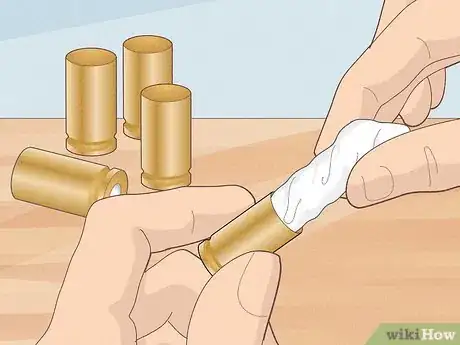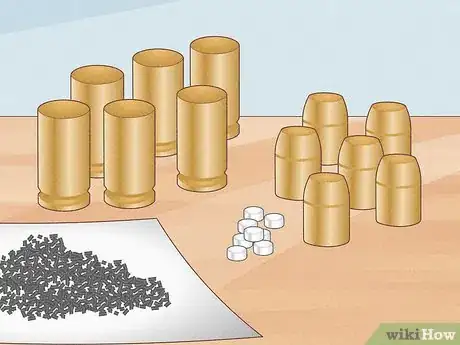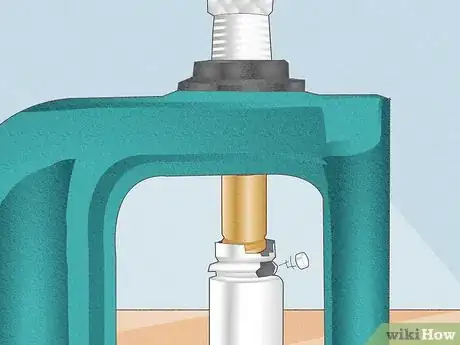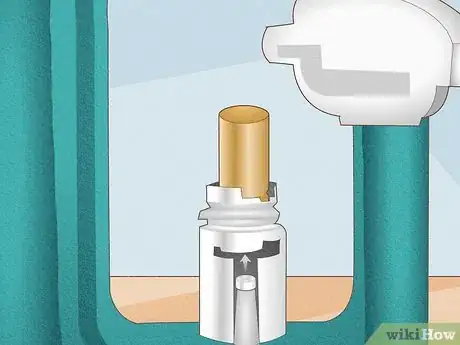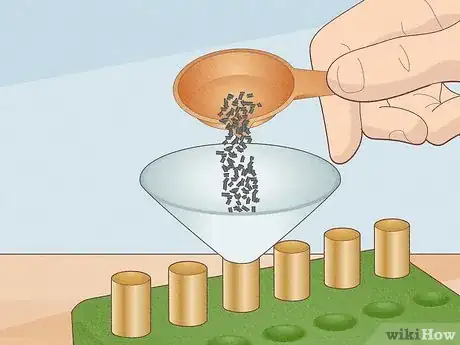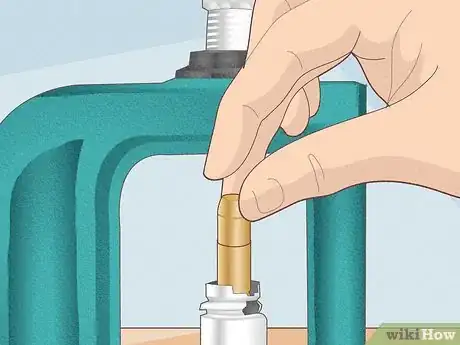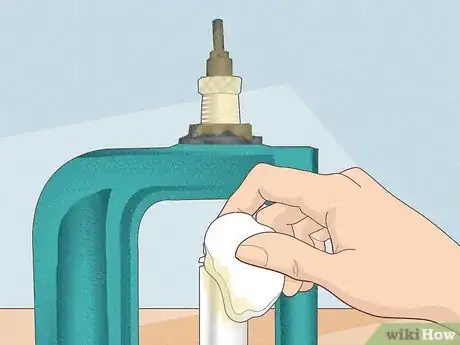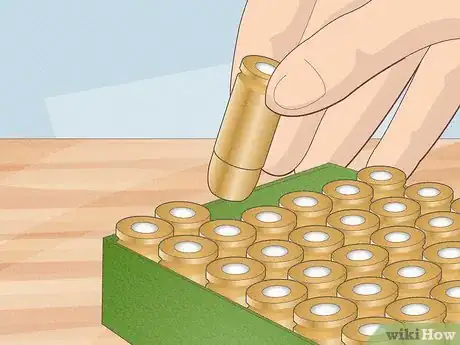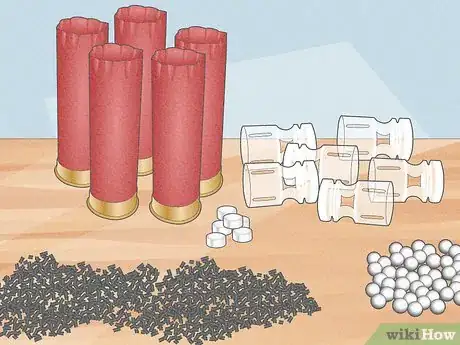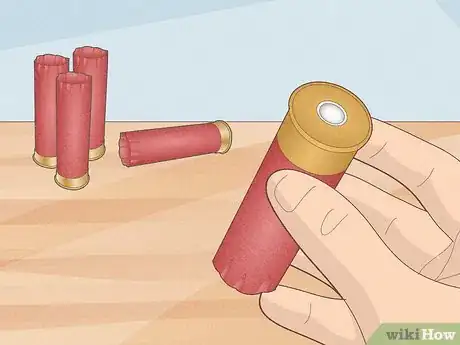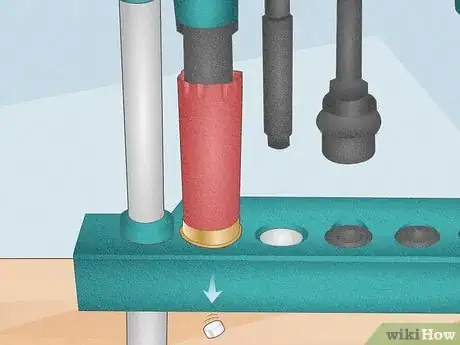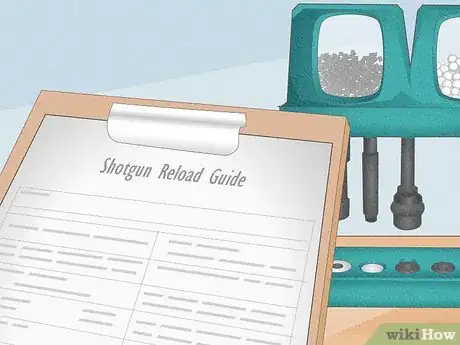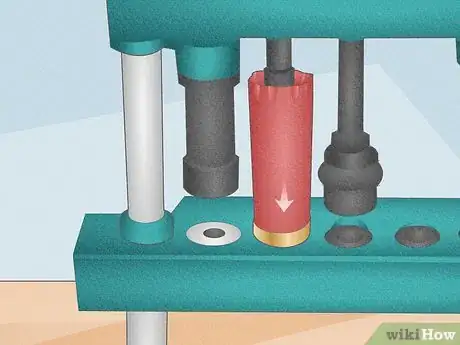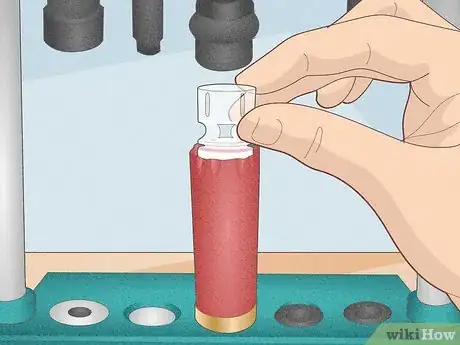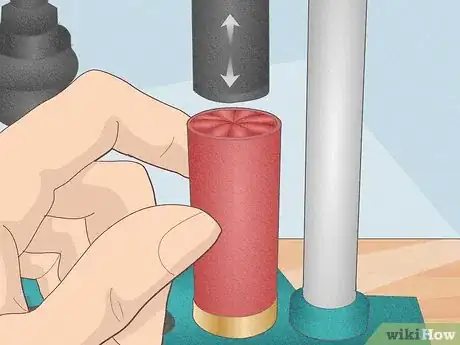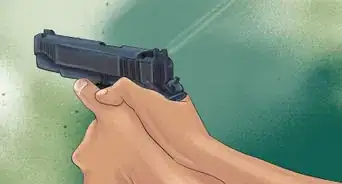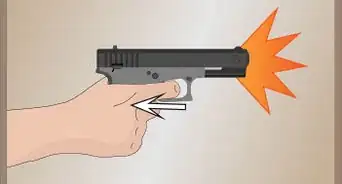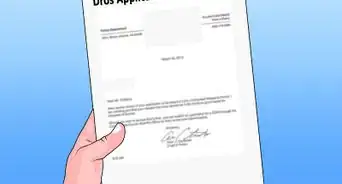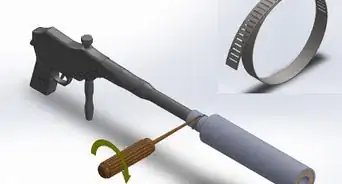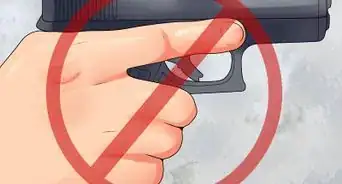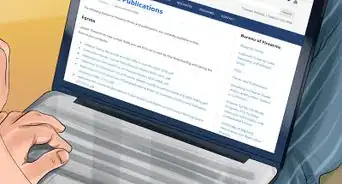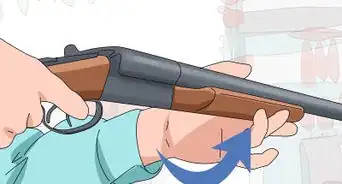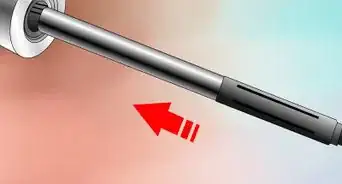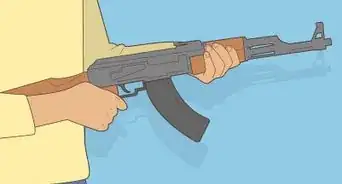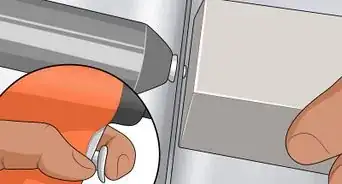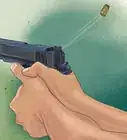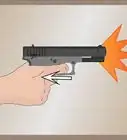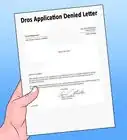wikiHow is a “wiki,” similar to Wikipedia, which means that many of our articles are co-written by multiple authors. To create this article, 23 people, some anonymous, worked to edit and improve it over time.
wikiHow marks an article as reader-approved once it receives enough positive feedback. In this case, 88% of readers who voted found the article helpful, earning it our reader-approved status.
This article has been viewed 263,580 times.
Learn more...
If you're a regular on the shooting range, reloading your empty rounds is a good way to save money and keep yourself loaded up. Whether you're scrounging up loose brass and empty shotgun shells at the gun range or just saving your own empties, investing in the materials and tools for the job is a smart idea for any sportsman. See Step 1 for more information.
Things You Should Know
- For a brass casing, insert a new primer and fill the casing with the correct type and amount of powder. Use the press handle to crimp the casing.
- For a shotgun casing, fit the empty shell into a reloader and rotate the plate. Add primer and powder. Insert wadding and shot, then crimp the shell.
- Put brass casings in cartridge boxes and shotgun casings in shell trays. Then, store the ammo in a cool, dry location.
Steps
Reloading Brass Casings
-
1Clean the casings. Check the brass cases for defects and discard any that are have cracks or excessive dents or bulges. Also, discard any that have deformed primers, indicating excessive pressure during firing.[1]
- Rub the inside of the case with a soft cloth to remove powder residue and dirt. Reach into the case with a case neck brush.
- Lubricate the casings to keep them from getting stuck in the sizing die. Spread a light coating of case lubricant on a lube pad and roll several casings across the pad at once. Reapply lubricant to the pad as needed.
-
2Assemble your reloading supplies. Aside from a reloading press and a bunch of free time, you will need:
- Cleaned and lubricated casings
- Primers
- Bullets the corresponding size of the shells you've collected
- Powder appropriate to the size of the shells you've collected
Advertisement -
3Remove the spent primers. Insert each case into the loading press. The handle should be positioned up. Lower the handle to resize the case and push the fired primer out. Raise the handle back up, remove the case and place it in a reloading tray. Repeat this step for all the cases.
- Some presses have a rotating tray that allows you to load several at once. You'll still want to go through the process of de-capping all of the spent casings before you go loading any of them. It'll be tedious, but worth it in the end.
-
4Insert a new primer into the case. Raise the handle to its highest position and place a new primer into the cup of the primer arm. Insert a case into the shell holder. Push the primer arm into the ram slot and lower the case onto the primer.[2]
- Remove the casing and inspect the primer. It should be flush or slightly lower than the case base.
-
5Reload the casing with the correct powder. Each type of size of shell requires a different variety and weight of powder. It is recommended that you buy a respected loading handbook such as the Alliant Powder Reloader's Guide that covers the calibers you intend to load. Follow their recommendations regarding powder and weight.[3]
- Weigh out the correct amount of powder. You can weigh each charge individually or use a volumetric powder measure or calibrated dipper.
- Add the powder using a funnel. Discard or return unused powder to the factory container. If it's left on your measurement device or other equipment, the powder can damage it. Keep the reloading area clean and free of powder.
-
6Seat the bullet. The seating die pushes a bullet to the proper depth in the neck of the case and crimps the shell. Put one of your casings in the shell holder, lowering the press handle to crimp the casing, securing it in place with the lock ring. Consult the owner's manual for more guidance regarding crimping.[4]
- Hold a bullet over the open casing with one hand while you lower the press handle with the other. If the bullet needs to be seated deeper into the case, adjust the seater.
-
7Clean and apply a light coat of gun oil to your dies and ram after you reload ammo. You can also lubricate moving parts on the shell loader with gun oil.[5]
-
8Place the ammo in cartridge boxes. Secure your reloaded ammunition in a lockbox separate from your firearms. Store the lockbox in a cool, dry location.
Reloading Shotgun Shells
-
1Assemble the necessary materials. Each shotgun shell consists of five basic components, somewhat less complex than the materials available for reloading brass. To reload empty shot shells, you'll need:
- Empty hulls, checked for wear
- Plastic wadding of the appropriate gauge
- Shot of the desired "shot number"
- Primers
- Shotshell powder
-
2Check your empty shells for reusable hulls. The only reusable component of the shotgun shell is the plastic shell itself, which is ejected from the shotgun after firing a round. To find reusable hulls, look for signs of wear around the mouth of the shell. They should be relatively uniform, rounded and intact plastic casings to reload.
- Hold potential reload hulls up to the light and examine the mouth of each for splits and substantial wear along the crimping. If it's too torn up, you won't be able to use it to properly crimp back down, resulting in a faulty shell.
- Generally, it's a good idea to throw away shells that have been stepped on or jammed with mud in some way. Shells that come from break-open shotguns that allow you to remove the empty shells directly from the gun are your safest bet. Put them directly into a box or bag to keep them, if you want to reload.
-
3Deprime your shells. When you fit the empty shell into the slot on your reloader, the first step is relatively simple. Pull the lever, and the uncapping pin will remove the spent cap from the empty shell, also resizing the casing to proper specifications. If the shell has warped some in transport, this step should round it back out some.[6]
-
4Consult a reload guide for load sizes. The safest way to make sure that you're reloading your shells to the proper specifications is to consult a trusty reload guide like the Alliant Guide. Included will be a rundown of powder weights, shot types, and primers used in all brands and varieties of shells. If you're planning on reloading regularly, it's essential to invest in one of these guides.
-
5Rotate the shell plate to load the shell with primer and powder. Each reloader will work differently, so you might check your owner's manual from your reloading press for a proper guide.
- Most reload guides call for Red Dot shotshell powder for use in reloading, of a varying amount.12 ga. shells are usually loaded with between 16 and 25 grains of powder.
- Most reloaders have a rotating plate that allows you to keep a load of each necessary "ingredient" queued up, allowing you to work relatively quickly. To advance between the steps, you simply rotate the plate and pull the handle again. You can go as quickly as you can do that simple action.
-
6Seat the wadding and the shot. Rotate the plate again and use the lever to insert your plastic wadding and the appropriate amount of sized shot for your variety of shell.[7]
- You've got some choice in the matter when it comes to what shot you want to load your shells with, depending on your purposes. 12 gauge shells generally use size 7.5, 8, or 9 size shot, sold in big 25 pound bags. The smaller the number, the larger the little lead balls. If you're shooting for sport, 8 or 9 is generally better, while you might want size 7.5 if you're hunting or reloading for some other purpose.
-
7Crimp the shell. Rotate the reloader again to crimp the shells closed, securing the completed shell. Store them in shotshell trays, widely available at sporting goods stores or other outlets, or just put them back in the old boxes that the shells came in.
- If you've altered the shells in any way--using different sizes of shot or made other manual-approved modifications--make note of it on the box so you know what you're shooting.
Community Q&A
-
QuestionHow can I remove a live primer from the casing?
 Community AnswerYou can, but in all cases shouldn't, as it is very perilous to do so, and imposes a great risk to you and your envirnoment.
Community AnswerYou can, but in all cases shouldn't, as it is very perilous to do so, and imposes a great risk to you and your envirnoment. -
QuestionCan I crimp the brass casing if the opening is too big for the bullet?
 Community AnswerNo. You must use the correct shell casing for the bullet and caliber. Doing otherwise puts yourself in danger of injury.
Community AnswerNo. You must use the correct shell casing for the bullet and caliber. Doing otherwise puts yourself in danger of injury. -
QuestionCan I use black powder as an emergency load?
 Community AnswerYes, but it could cause damage to the weapon if you load too much in, and the fowling caused by it would be difficult to clean out.
Community AnswerYes, but it could cause damage to the weapon if you load too much in, and the fowling caused by it would be difficult to clean out.
Warnings
- Using the incorrect variety or amount of powder can cause the rounds to misfire, possibly resulting in injury or death. Consult a reloading handbook to determine the correct amount of powder for the casings you intend to reload.⧼thumbs_response⧽
Things You'll Need
- Casings
- Case neck brush
- Case lubricant
- Lubricant pad
- Soft cloths
- Shell loader and dies
- Caliper or case gauge
- Trimmer
- Reloading trays
- Primers
- Handloading manual
- Powder
- Devise for weighing powder
- Powder funnel
- Cartridge boxes
- Lockbox
- Gun oil
- Safety glasses
References
- ↑ https://gunloading.com/beginners-guide-to-reloading/
- ↑ https://www.rcbs.com/step-by-step-reloading.html
- ↑ https://www.pewpewtactical.com/beginners-guide-to-reloading-ammo/
- ↑ https://www.pewpewtactical.com/beginners-guide-to-reloading-ammo/
- ↑ https://gunloading.com/beginners-guide-to-reloading/
- ↑ https://www.gunsandammo.com/editorial/introduction-to-shotshell-reloading/365540
- ↑ https://www.gunsandammo.com/editorial/introduction-to-shotshell-reloading/365540
About This Article
To reload brass casings, you’ll need cleaned and lubricated casings, primers, and bullets and powder that match the size of your shells. Once you have your supplies, use a loading press to resize each case and push the fired primer out so you can remove the spent primers. When you’ve done that with all your cases, insert a new primer into the cup of the primer arm and then put a case into the shell holder. After you’ve lowered the case onto the primer, weigh out the correct type and amount of powder based on your shells and reload the casing with it. Seat the bullet by securing one of your casings in the shell holder. Remember to clean your dies with a light coat of gun oil after you’ve reloaded your ammo so it’s well lubricated! For more information, including how to reload shotgun shells, scroll down.
